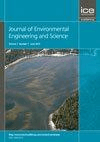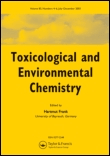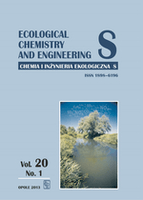
Journal of Hazardous Materials Advances
Scope & Guideline
Bridging gaps between research and environmental action.
Introduction
Aims and Scopes
- Assessment and Remediation of Contaminants:
Research on the detection, characterization, and remediation of hazardous pollutants in various environmental mediums, including water, soil, and air. - Sustainable Waste Management:
Focus on strategies for managing hazardous wastes, including recycling, recovery, and treatment technologies, to minimize environmental impact. - Health Risk Assessment:
Investigating the health impacts of hazardous materials exposure, including the assessment of carcinogenic and non-carcinogenic risks associated with various pollutants. - Development of Advanced Materials and Technologies:
Innovations in materials science, particularly nanotechnology, for the removal and degradation of hazardous substances, as well as the development of eco-friendly materials. - Microplastics and Emerging Contaminants:
Research on the sources, fate, and effects of microplastics and other emerging pollutants, along with potential mitigation strategies.
Trending and Emerging
- Nanotechnology in Environmental Remediation:
An increasing number of studies focus on the application of nanomaterials for the removal and degradation of pollutants, highlighting the potential of nanotechnology to enhance remediation efficiency. - Impact of Climate Change on Contaminant Behavior:
Research is increasingly exploring how climate change influences the behavior and risks of hazardous materials, particularly in relation to water quality and pollutant mobility. - Circular Economy Approaches:
There is a growing emphasis on circular economy principles in hazardous materials management, focusing on waste minimization, resource recovery, and sustainable product design. - Integrated Assessment of Microplastics:
Emerging research on microplastics is increasingly integrated with studies on other pollutants, emphasizing the need for comprehensive assessments of environmental and health impacts. - Health Impacts of Chemical Exposure:
A trend towards more detailed investigations into the health effects of exposure to a wider range of hazardous materials, including pharmaceuticals and personal care products, is becoming prominent.
Declining or Waning
- Traditional Heavy Metal Remediation Techniques:
Research on conventional methods for heavy metal remediation appears to be waning as newer, more innovative approaches gain traction, such as bioremediation and advanced nanomaterials. - Single-Pollutant Studies:
There is a noticeable decline in studies focusing solely on single pollutants, with a shift towards integrated approaches that consider multiple contaminants and their interactions. - Chemical Warfare Agents:
The frequency of studies specifically addressing chemical warfare agents has decreased, possibly due to a shift in focus towards broader hazardous materials and environmental health issues.
Similar Journals

Journal of Environmental Engineering and Science
Championing Academic Excellence in Environmental ScienceJournal of Environmental Engineering and Science, published by Emerald Group Publishing Ltd, is a prominent academic platform dedicated to the dissemination of cutting-edge research in the fields of environmental engineering, chemistry, and science. This journal, with ISSN 1496-2551 and E-ISSN 1496-256X, features a comprehensive collection of studies that delve into innovative methodologies and practical applications aimed at solving pressing environmental issues. Having been published since 2002, it spans critical research years from 2015 to 2024, offering insights that are invaluable to both academics and practitioners alike. With its current rankings placing it in the fourth quartile for Environmental Chemistry and Engineering, and the third quartile in miscellaneous Environmental Science, the journal serves as a significant yet under-utilized resource for emerging scholars seeking to contribute to the ecological discourse. Though it does not offer Open Access, the content is meticulously curated to uphold academic rigor, catering especially to researchers, professionals, and students keen on advancing their understanding of environmental challenges and engineering solutions.

Biochar
Advancing Soil Health with Groundbreaking Biochar ResearchWelcome to Biochar, an esteemed academic journal dedicated to the exploration and advancement of biochar technology and its applications across multiple fields. Published by SPRINGER SINGAPORE PTE LTD, this journal serves as a vital platform for disseminating high-quality research that addresses the critical intersection of environmental science, soil health, and sustainable materials development. With a commendable Q1 ranking in the fields of Biomaterials, Environmental Science, Pollution, and Soil Science, Biochar is recognized for its significant impact, as evidenced by its placement in the upper percentiles across various Scopus rankings. Researchers and professionals in agricultural and biological sciences will find valuable insights and innovative methodologies that promote sustainable practices and enhance soil quality. This journal, operating from its base in Germany, is committed to fostering a collaborative environment where cutting-edge research can inform policy and practice. Engage with us as we strive to advance the science of biochar from 2019 to 2024 and beyond.

Recycling
Connecting researchers to foster environmental innovation.Recycling is a renowned international open access journal published by MDPI that has been dedicated to advancing the field of recycling and waste management since its inception in 2015. With a focus on innovative technologies, management practices, and policy frameworks, this journal serves as a platform for researchers, professionals, and students who are eager to explore sustainable solutions in resource recovery and material efficiency. Based in beautiful Basel, Switzerland, Recycling boasts an impressive impact with a 2023 ranking of Q2 in Management, Monitoring, Policy and Law and Q1 in Materials Science (Miscellaneous), signifying its pivotal role in driving forward-thinking research in these critical areas. The journal is indexed in Scopus, with strong performance metrics highlighting its relevance and quality, such as a rank of #42 in Waste Management and Disposal. As an open access publication, Recycling promotes the dissemination of knowledge, ensuring that groundbreaking research is freely available to a global audience. Whether you are a seasoned researcher or a student eager to contribute to the discourse surrounding sustainable practices, Recycling provides a vital resource for those committed to the future of waste management and environmental sustainability.

TOXICOLOGICAL AND ENVIRONMENTAL CHEMISTRY
Unraveling the complexities of chemicals and their environmental effects.TOXICOLOGICAL AND ENVIRONMENTAL CHEMISTRY is a pivotal journal published by Taylor & Francis Ltd, addressing critical intersections between environmental chemistry and toxicology since its inception in 1979. With its ISSN 0277-2248 and E-ISSN 1029-0486, the journal serves as a platform for rigorous research and innovative methodologies in pollution control, health implications of environmental chemicals, and the broader spectrum of toxicological studies. Although it currently does not offer open access, the journal's impact in the field is underscored by its Category Quartiles rankings in 2023, placing it in Q3 across Environmental Chemistry, Health, Toxicology and Mutagenesis, and Pollution categories. Furthermore, its Scopus rankings reveal its significant role within the scientific community, specifically in areas such as Environmental Science and Toxicology. The journal aspires to foster multidisciplinary dialogue and advance knowledge that contributes to environmental sustainability and public health, making it an essential resource for researchers, professionals, and students dedicated to these fields.

International Journal of Environmental Science and Technology
Pioneering research at the intersection of science and technology.International Journal of Environmental Science and Technology, published by SPRINGER, stands as a premier platform for the dissemination of cutting-edge research in the fields of environmental science, technology, and engineering. With an impressive scope spanning from 2005 to 2024, this journal serves as a vital resource for academic and professional communities engaged in tackling pressing environmental challenges. It boasts a strong reputation, evidenced by its Q1 ranking in Agricultural and Biological Sciences and solid placements in Environmental Chemistry and Engineering. Researchers searching for high-impact studies will find the journal's contributions significant, as reflected in its rankings within Scopus: 34th percentile in Agricultural and Biological Sciences and notable standings in Environmental Engineering and Chemistry. Although the journal is not currently an Open Access resource, it maintains a commitment to academic rigor and innovation, making it indispensable for those devoted to advancing knowledge in environmental sustainability and technology.

Ecological Chemistry and Engineering S-Chemia I Inzynieria Ekologiczna S
Innovative Research at the Intersection of Chemistry and EcologyEcological Chemistry and Engineering S, a prominent journal in the field of Environmental Chemistry and Engineering, provides a platform for innovative research and critical discussions surrounding ecological solutions and sustainable practices. Published by SCIENDO, this peer-reviewed journal is accessible to researchers and professionals dedicated to advancing our understanding of ecological systems and sustainable engineering practices. With an ISSN of 1898-6196 and an E-ISSN of 2084-4549, the journal has established itself in the academic community, reflected by its Q3 ranking in both Environmental Chemistry and Environmental Engineering categories as of 2023. Covering significant advancements from 2008 to 2024, it serves as an essential resource in advancing knowledge and fostering collaborations within interdisciplinary fields. Despite not offering open access, the journal remains an invaluable resource for researchers and students aiming to contribute to ecological sustainability strategies worldwide.

Environmental Health Engineering and Management Journal
Transforming Environmental Insights into Health SolutionsEnvironmental Health Engineering and Management Journal is a premier platform dedicated to the dissemination of research findings in the essential field of environmental health. Published by Kerman University of Medical Sciences in Iran, this Open Access journal has been a beacon of scientific inquiry since its inception in 2014. With an ISSN of 2423-3765 and E-ISSN 2423-4311, it facilitates broad accessibility to cutting-edge research that addresses the complex interactions between environmental factors and human health. With a notable categorization in the Q3 quartile for Environmental Science and Public Health, alongside Q4 in Chemical Health and Safety, the journal underscores its commitment to quality and relevance. Currently ranked #132 out of 233 in Environmental Science within Scopus, it serves as a crucial resource for researchers and practitioners striving to tackle contemporary environmental challenges. The journal's scope includes innovative methodologies, environmental risk assessment, and sustainable health practices, positioning it as an indispensable reference for those invested in improving public health outcomes through environmental engineering and management.

International Journal of Environment and Waste Management
Championing Research for Environmental ResilienceThe International Journal of Environment and Waste Management, published by InderScience Enterprises Ltd, serves as a vital platform for researchers and professionals in the fields of Environmental Engineering and Waste Management. With an ISSN of 1478-9876 and an E-ISSN of 1478-9868, this journal encompasses a wide range of topics from innovative technologies in waste processing to sustainable environmental practices. Ranked in the Q3 category for Environmental Engineering and Q4 for Waste Management and Disposal in 2023, it holds significance in advancing knowledge and impacting practices in these essential domains. The journal accepts articles that contribute to the understanding and development of effective waste management strategies, ensuring alignment with contemporary environmental challenges. As it converges years from 2006 to 2024, it continues to attract contributions that reflect the latest research and methodologies. For scholars, students, and practitioners alike, this journal is an invaluable resource, enriching the dialogue around environmental sustainability and waste minimization.

University Politehnica of Bucharest Scientific Bulletin Series B-Chemistry and Materials Science
Pioneering Research for Tomorrow's ChallengesUniversity Politehnica of Bucharest Scientific Bulletin Series B-Chemistry and Materials Science is a renowned academic journal published by POLYTECHNIC UNIV BUCHAREST, situated in Romania. With the ISSN 1454-2331, this journal serves as a dynamic platform for the dissemination of innovative research findings in the fields of chemistry and materials science. Although classified in the Q4 quartile of both Chemistry (miscellaneous) and Materials Science (miscellaneous) categories for 2023, it has made a significant impact by providing a venue for emerging scholars and established researchers alike to share their work. The journal seeks to bridge theoretical insights and practical applications, promoting interdisciplinary dialogue and advancing scientific understanding. The scope encompasses a broad range of topics, reflecting contemporary advancements and challenges within the field. To facilitate access to its articles, while it does not currently operate under an open-access model, the journal remains committed to enhancing visibility through digital libraries. With a publication history spanning from 1999 to 2024, the journal is vital for all stakeholders—researchers, professionals, and students—seeking to stay abreast of developments in chemistry and materials science.

Environment Protection Engineering
Innovating Waste Management for Environmental ResilienceEnvironment Protection Engineering is a peer-reviewed academic journal published by Technical University of Wroclaw, dedicated to advancing knowledge and research in the fields of environmental engineering and waste management. With a rich publishing history dating back to 1980, the journal encompasses a wide spectrum of topics, from innovative engineering solutions to the effective management of waste, promoting sustainable practices and environmental protection methodologies. Despite its recent classification in the Q4 quartile of both Environmental Engineering and Waste Management and Disposal, the journal serves as a critical platform for researchers, professionals, and students seeking to disseminate their findings and engage with current challenges faced in environmental science. Located in Poland, the journal supports the scholarly community by providing insightful articles that contribute to the discourse surrounding environmental sustainability. Though currently not available as an open-access publication, it remains an essential resource for those aspiring to deepen their understanding of pressing ecological issues and solutions.